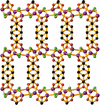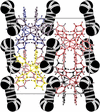issue contents
July 2021 issue

Cover illustration: The cis isomer of bis(L-DOPA-κ2N,O)copper(II) monohydrate, a singular example of a structurally characterized, homoleptic, crystalline metal L-DOPA complex, crystallizes in the space group P21, with Z′ = 2. The two independent molecules are square planar and are interconnected by an unusual linear hydrogen-bonded chain containing 12 independent hydrogen bonds. Pseudosymmetry along a 42 axis was analyzed using the MATCH procedure in the Crystals for Windows program. See O'Brien, Poyner, Alraddadi, Hursthouse & Foxman [Acta Cryst. (2021), C77, 283–290].
research papers






 access
access





 access
access





 access
access





 access
access

 access
access



 journal menu
journal menu































